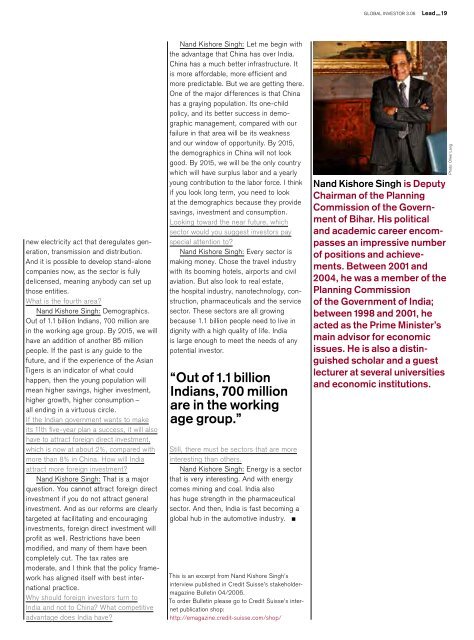Banking for 7 billion and 7 million
New challenges and opportunities of globalization Global Investor, 03/2006 Credit Suisse
New challenges and opportunities of globalization
Global Investor, 03/2006
Credit Suisse
Create successful ePaper yourself
Turn your PDF publications into a flip-book with our unique Google optimized e-Paper software.
GLOBAL INVESTOR 3.06 Lead — 19<br />
new electricity act that deregulates generation,<br />
transmission <strong>and</strong> distribution.<br />
And it is possible to develop st<strong>and</strong>-alone<br />
companies now, as the sector is fully<br />
delicensed, meaning anybody can set up<br />
those entities.<br />
What is the fourth area?<br />
N<strong>and</strong> Kishore Singh: Demographics.<br />
Out of 1.1 <strong>billion</strong> Indians, 700 <strong>million</strong> are<br />
in the working age group. By 2015, we will<br />
have an addition of another 85 <strong>million</strong><br />
people. If the past is any guide to the<br />
future, <strong>and</strong> if the experience of the Asian<br />
Tigers is an indicator of what could<br />
happen, then the young population will<br />
mean higher savings, higher investment,<br />
higher growth, higher consumption –<br />
all ending in a virtuous circle.<br />
If the Indian government wants to make<br />
its 11th five-year plan a success, it will also<br />
have to attract <strong>for</strong>eign direct investment,<br />
which is now at about 2%, compared with<br />
more than 8% in China. How will India<br />
attract more <strong>for</strong>eign investment?<br />
N<strong>and</strong> Kishore Singh: That is a major<br />
question. You cannot attract <strong>for</strong>eign direct<br />
investment if you do not attract general<br />
investment. And as our re<strong>for</strong>ms are clearly<br />
targeted at facilitating <strong>and</strong> encouraging<br />
investments, <strong>for</strong>eign direct investment will<br />
profit as well. Restrictions have been<br />
modified, <strong>and</strong> many of them have been<br />
completely cut. The tax rates are<br />
moderate, <strong>and</strong> I think that the policy framework<br />
has aligned itself with best international<br />
practice.<br />
Why should <strong>for</strong>eign investors turn to<br />
India <strong>and</strong> not to China? What competitive<br />
advantage does India have?<br />
N<strong>and</strong> Kishore Singh: Let me begin with<br />
the advantage that China has over India.<br />
China has a much better infrastructure. It<br />
is more af<strong>for</strong>dable, more efficient <strong>and</strong><br />
more predictable. But we are getting there.<br />
One of the major differences is that China<br />
has a graying population. Its one-child<br />
policy, <strong>and</strong> its better success in demographic<br />
management, compared with our<br />
failure in that area will be its weakness<br />
<strong>and</strong> our window of opportunity. By 2015,<br />
the demographics in China will not look<br />
good. By 2015, we will be the only country<br />
which will have surplus labor <strong>and</strong> a yearly<br />
young contribution to the labor <strong>for</strong>ce. I think<br />
if you look long term, you need to look<br />
at the demographics because they provide<br />
savings, investment <strong>and</strong> consumption.<br />
Looking toward the near future, which<br />
sector would you suggest investors pay<br />
special attention to?<br />
N<strong>and</strong> Kishore Singh: Every sector is<br />
making money. Chose the travel industry<br />
with its booming hotels, airports <strong>and</strong> civil<br />
aviation. But also look to real estate,<br />
the hospital industry, nanotechnology, construction,<br />
pharmaceuticals <strong>and</strong> the service<br />
sector. These sectors are all growing<br />
because 1.1 <strong>billion</strong> people need to live in<br />
dignity with a high quality of life. India<br />
is large enough to meet the needs of any<br />
potential investor.<br />
“Out of 1.1 <strong>billion</strong><br />
Indians, 700 <strong>million</strong><br />
are in the working<br />
age group.”<br />
Still, there must be sectors that are more<br />
interesting than others.<br />
N<strong>and</strong> Kishore Singh: Energy is a sector<br />
that is very interesting. And with energy<br />
comes mining <strong>and</strong> coal. India also<br />
has huge strength in the pharmaceutical<br />
sector. And then, India is fast becoming a<br />
global hub in the automotive industry. <br />
This is an excerpt from N<strong>and</strong> Kishore Singh’s<br />
interview published in Credit Suisse’s stakeholdermagazine<br />
Bulletin 04/2006.<br />
To order Bulletin please go to Credit Suisse’s internet<br />
publication shop:<br />
http://emagazine.credit-suisse.com/shop/<br />
N<strong>and</strong> Kishore Singh is Deputy<br />
Chairman of the Planning<br />
Commission of the Government<br />
of Bihar. His political<br />
<strong>and</strong> academic career encompasses<br />
an impressive number<br />
of positions <strong>and</strong> achievements.<br />
Between 2001 <strong>and</strong><br />
2004, he was a member of the<br />
Planning Commission<br />
of the Government of India;<br />
between 1998 <strong>and</strong> 2001, he<br />
acted as the Prime Minister’s<br />
main advisor <strong>for</strong> economic<br />
issues. He is also a distinguished<br />
scholar <strong>and</strong> a guest<br />
lecturer at several universities<br />
<strong>and</strong> economic institutions.<br />
Photo: Oliver Lang

















